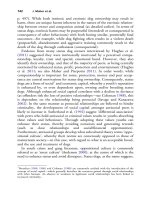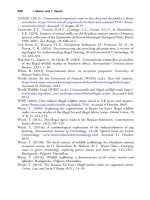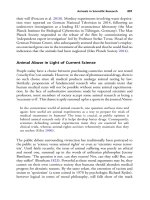The palgrave international handbook of a 132
Bạn đang xem bản rút gọn của tài liệu. Xem và tải ngay bản đầy đủ của tài liệu tại đây (27.37 KB, 1 trang )
122
A. Arluke et al.
Several dozen states have legislated mandatory or discretionary psychological evaluation of persons convicted of animal maltreatment, including
animal hoarding (Phillips and Lockwood 2013). In principle, this seems to
be a worthwhile step. In reality, although courts may order evaluation or
counseling for animal hoarders, the goals of such an evaluation are not
specified, and no validated therapy for animal-hoarding disorder is currently available. Furthermore, it is unknown what qualifications and skills
the therapist or evaluator would need to have, what the expected outcomes
of the process would be (for example, is a ‘cure’ even possible), how long
the process might take, what should be done with the animal victims while
a convicted offender would be in treatment, and whether convicted offenders could ever be trusted to provide a safe environment for animals in the
future.
In addition, most individuals who have been adjudicated for animal
hoarding are reluctant to participate in therapy and resistant to change,
making this strategy difficult to enforce even if treatment were available
(Frost et al. 2000; Nathanson 2009). This seems to be a case where laws are
vague and far ahead of clinical mental health practice. Even if hoarders visit
therapists, their cognitive distortions can complicate treatment and frustrate practitioners. A common characteristic of animal hoarders is their use
of denial or other methods of justification for their situation and the refusal
to acknowledge that a problem exists (Nathanson 2009; Patronek 1999).
Vaca-Guzman and Arluke (2005) identified three types of justifications,
including total denial, being a Good Samaritan, and being ‘victims of the
system.’ In particular, saving animals from death is a recurrent theme used
by hoarders to justify their behavior. Most cannot accept the concept of ‘a
life not worth living’ even if that involves prolonged pain and suffering.
This is a major philosophical divide between animal hoarders and conventional animal welfare and sheltering professionals who view euthanasia as
an acceptable tool for the alleviation of suffering. This divide often leads
animal hoarders to claim that officials and/or animal groups intervening in
cases had personal vendettas against them, and that the whole ‘system’ was
against them.
Since many studies of animal hoarding report extremely high rates of
recidivism (McKay 2008), it is essential that an emphasis be placed on taking
steps to limit the frequency with which people reacquire multiple animals
after having animals legally removed (Steketee et al. 2011). Although progress continues to be made, object hoarding is still considered a very treatment-resistant condition requiring an experienced therapist. So any notion of
a quick-fix for animal hoarding should be viewed with some skepticism.









